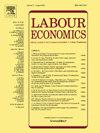性别规范和儿童惩罚
IF 2.6
2区 经济学
Q2 ECONOMICS
引用次数: 0
摘要
我研究早期的性别观念如何影响为人父母对劳动力市场的影响。根据NLSY79的面板数据,我记录了分娩后在工资、工作时间、就业和收入方面明显而持续的性别差距。拥有平等主义规范的母亲在所有结果中都表现出更强的劳动力依恋,受到的惩罚也更小。为了理解其中的机制,我证明了性别规范会影响那些通常与劳动力市场成功相关的决策。一项因果中介分析显示,规范信念对生育率的间接影响解释了现代母亲与传统母亲之间相当大的差距,而教育、结婚时机和职业分类的作用则更为有限。本文章由计算机程序翻译,如有差异,请以英文原文为准。
Gender norms and child penalties
I study how early gender beliefs shape the labor market consequences of parenthood. Drawing on panel data from the NLSY79, I document sharp and persistent gender gaps in wages, hours, employment, and earnings following childbirth. Mothers with egalitarian norms exhibit stronger labor force attachment and suffer smaller penalties across all outcomes. To understand mechanisms, I demonstrate that gender norms affect decisions that typically correlate with labor market success. A causal mediation analysis reveals that the indirect effect of norm beliefs on fertility explain a sizable share of the gap between modern and traditional mothers, while education, marriage timing, and occupational sorting play more limited roles.
求助全文
通过发布文献求助,成功后即可免费获取论文全文。
去求助
来源期刊

Labour Economics
ECONOMICS-
CiteScore
3.60
自引率
8.30%
发文量
142
期刊介绍:
Labour Economics is devoted to publishing research in the field of labour economics both on the microeconomic and on the macroeconomic level, in a balanced mix of theory, empirical testing and policy applications. It gives due recognition to analysis and explanation of institutional arrangements of national labour markets and the impact of these institutions on labour market outcomes.
 求助内容:
求助内容: 应助结果提醒方式:
应助结果提醒方式:


